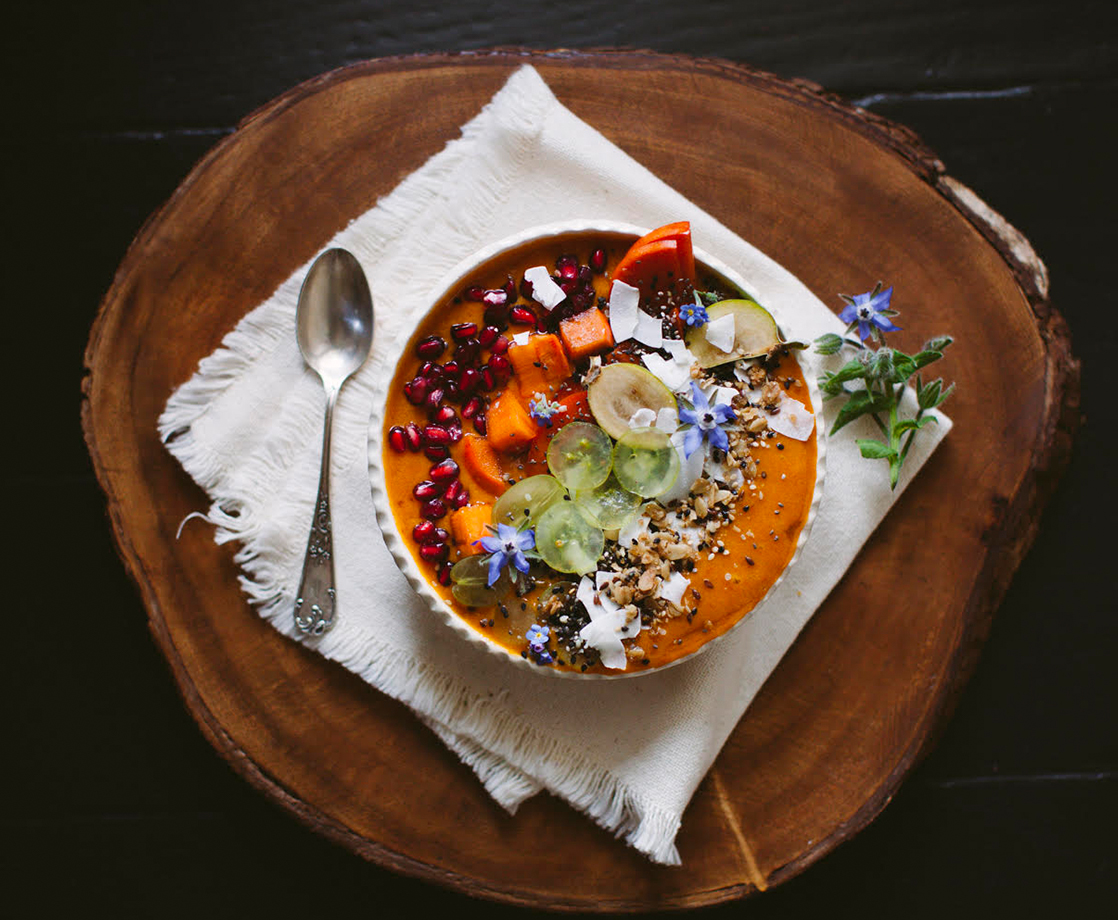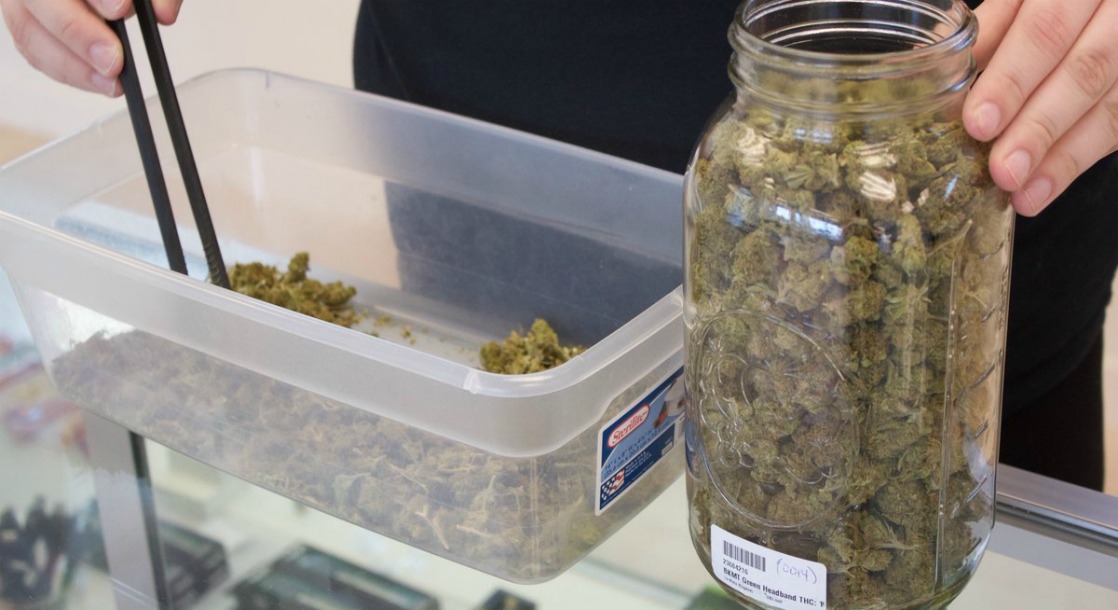Photos by Shannon Paras, courtesy of Stephany Gocobachi
As cannabis legalization continues to spread, legal weed companies are pushing the limits of what is possible with pot. When it comes to edibles, that often means packing as much THC as a state will allow into each bite-sized chocolate square, or private chefs turning out decadent, exclusive CBD-infused dinners worthy of Michelin stars. Sometimes, though, that pomp, circumstance, and processing can take away from the herbaceous flower itself.
But while some edible companies may focus on churning out as many gummies as possible, Stephany Gocobachi is bringing the cannabis plant back to the kitchen and focusing on culinary infusions that not only highlight weed’s psychoactive effects, but also the flavors, textures, and health benefits of our favorite bud.
Born in San Francisco and raised throughout the Bay Area, Gocobachi found her passion for food at a young age. She then turned her childhood hobby into an adult job, working in professional pastry kitchens while finishing school and planning her THC-infused future. In 2015, Gocobachi and her partner, chef Akhil Khadse, launched the Flour Child Collective, introducing healthy, lifted fruit preservatives and granola to California’s medical cannabis community.
Produced with strain-specific flower rosin to match the flavors of the fruits, and created with locally-sourced ingredients, Gocobachi and Khadse quickly expanded their project to include a variety of health-focused infusions, and extended the Flour Child product line to include CBD topicals, as well as the same flower rosin used in their edibles.
To learn more about the Flour Child Collective, why rosin is the perfect form of cannabis to cook with, and what fruits pair best with which strains, MERRY JANE reached out to Stephany Gocobachi to get the lowdown — and she shared the recipe for her infused persimmon and turmeric smoothie bowl, too.
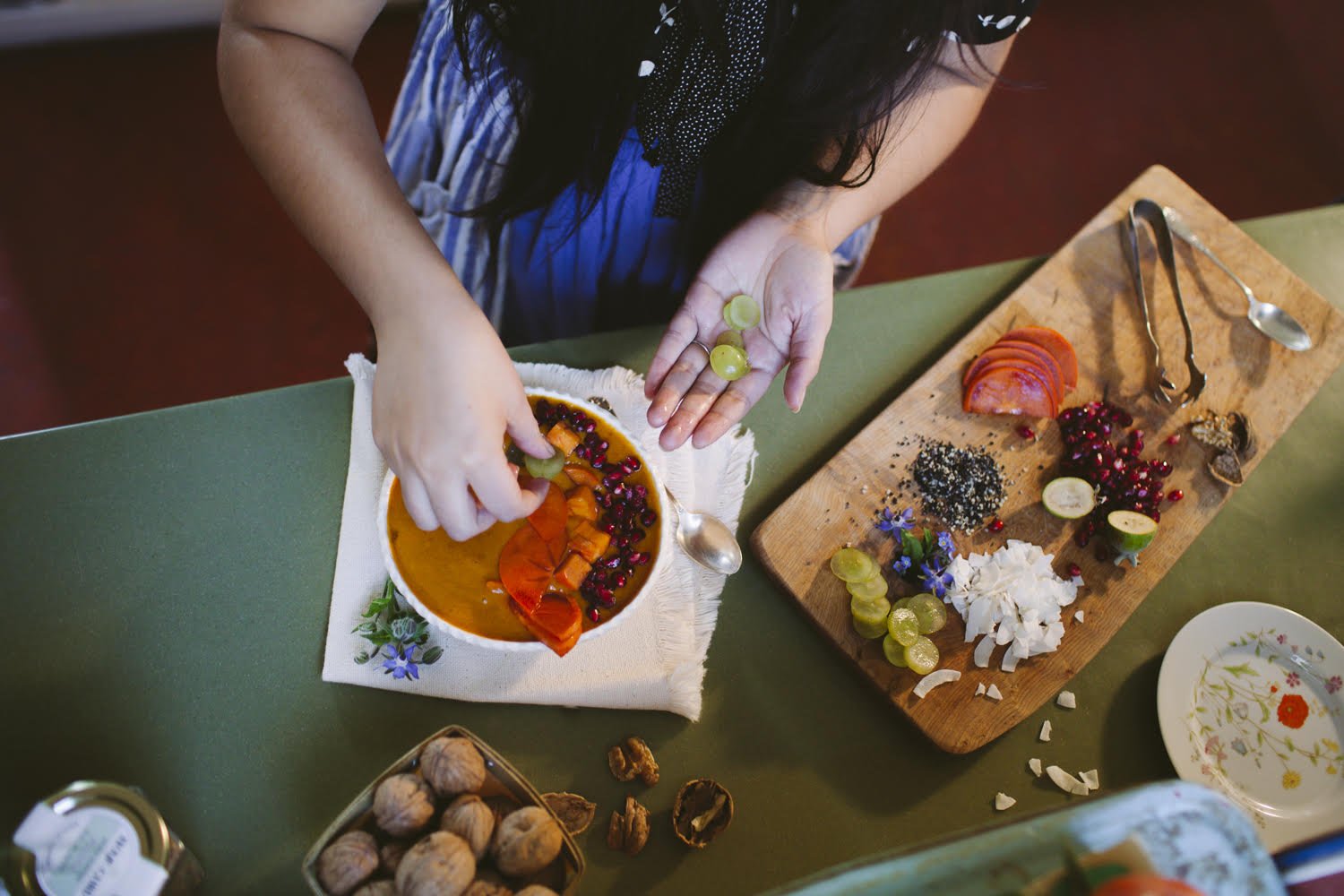
Flour Child’s Persimmon Turmeric Smoothie Bowl
Stephany Gocobachi: We are lucky to have access to three old hachiya persimmon trees at my mom’s house. They’re delicious and very prolific, so much so that we have to freeze the pulp to make into smoothies, ice cream, and cakes throughout the winter. So we usually have a few bags of sweet frozen hachiya pulp on hand, which is great in smoothies. You can substitute any other frozen fruit you like — bananas, peaches, berries, and mango would be really good, or a combination of all of them. For the turmeric base, we make a quick turmeric milk, fortified with black pepper and fenugreek (because they help our bodies better utilize the anti-inflammatory powers of curcumin), and we just had to add a dash of lemon zest because there was already black pepper and we all know how much Snoop loves lemon pepper…
The recipe is for a Persimmon Turmeric Smoothie Bowl that you can gussy up with any combination of your favorite toppings. We wanted to include a simple, healthy recipe that’s easy to tweak depending on what you like and what’s in your fridge. Also, it’s been a lifelong dream of mine to cook brunch for Snoop and Martha ever since I found out they were friends (long before their cooking show), because I mean, could there be a more iconic Flour Child pairing than that? I would probably make a huge feast, and this might be something on the spread. We’d include little dishes of all the various toppings so each guest could garnish to his of her heart’s content.

Turmeric Milk Ingredients:
– 1 cup cashew, almond, coconut, or organic cow's milk
– 2 tablespoons turmeric powder
– 1 teaspoon ginger powder or freshly grated ginger
– 1/8 teaspoon black pepper
– 1/4 teaspoon ground fenugreek
– Zest of one lemon (Meyer lemon if you can!)
Bring milk to just below a simmer. Whisk in spices and lemon zest. Let it infuse for 5 minutes, then remove from heat and cool. You can store it in the fridge and use throughout the week in smoothies and beverages.
Persimmon Smoothie Bowl Ingredients:
– 1 cup turmeric milk
– 2 cups frozen persimmon pulp, or frozen fruit of your choice (banana, mango, berries, etc.)
– 2 tablespoons almond or cashew butter (optional, for a protein boost)
– A few drops of your favorite oil-based cannabis tincture or olive oil (we love Pot D’Huile’s strain-specific extra virgin olive oil!)
Suggestions for Garnish:
– Toasted coconut flakes
– Granola
– Thinly sliced grapes
– Edible flowers
– Seeds — we like to mix hemp, flax, chia, and poppy seeds to sprinkle on everything
– Fresh fruit, sliced or diced (pomegranate, fuyu persimmon, pineapple guava, tiny tangerine segments!)
– Nuts, raw or toasted
Add the milk, fruit and almond butter to the blender jar. Add in the THC tincture or oil if you desire. Blend together until creamy and divide into two bowls. Garnish with whatever strikes your fancy! Have fun with it. It’s a nice way to slow down and take a few minutes to make yourself something beautiful and nourishing in the morning.
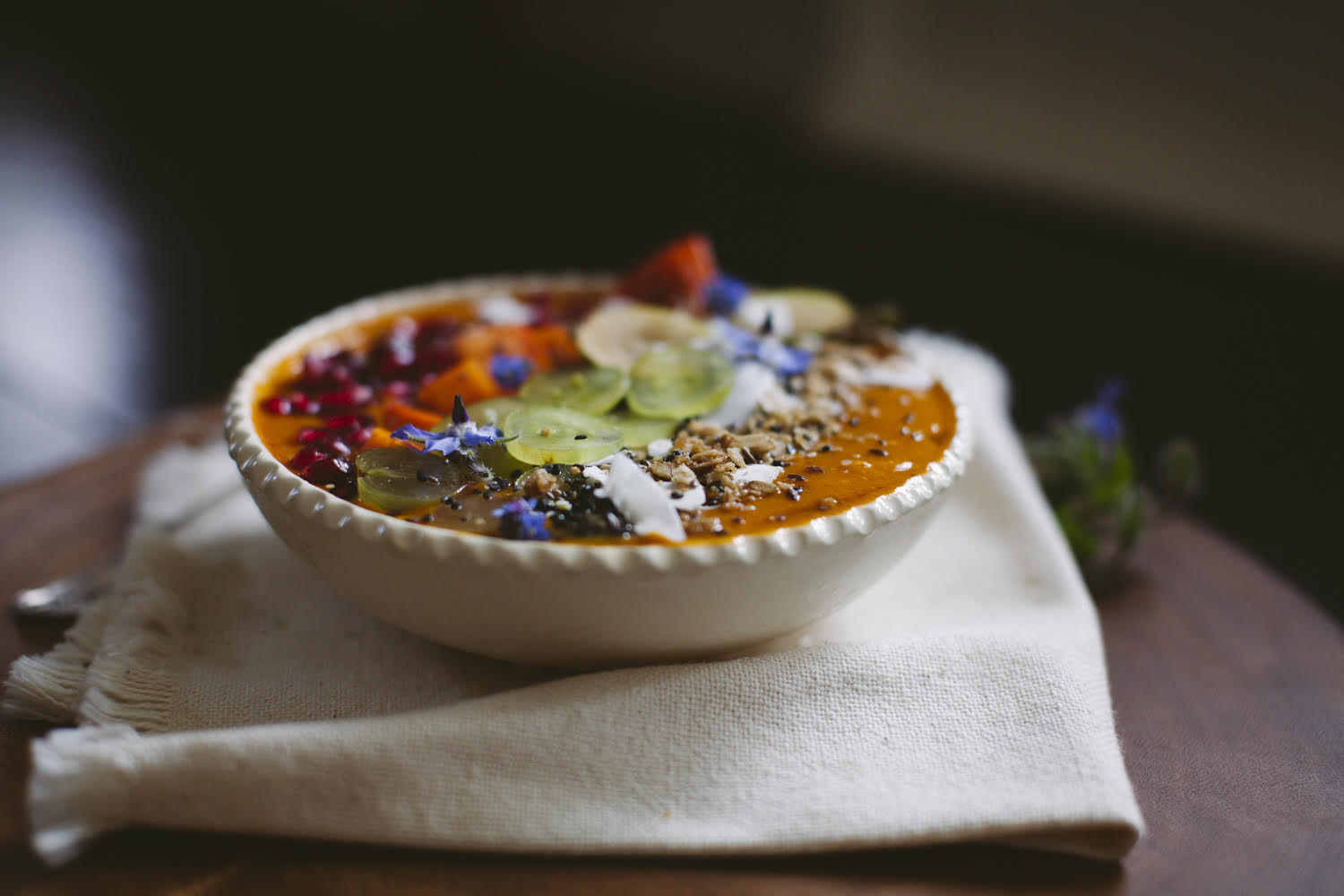
MERRY JANE: How did you first discover cannabis, and how did you initially get into making edibles?
Stephany Gocobachi: Well, I’ve always been obsessed with food and cooking. I was making kitchen messes ever since I could reach, and was an avid reader of Gourmet magazine by age 5. Like many, I first discovered cannabis as a teenager. It wasn’t long until I learned about edibles, and luckily one of my best friends’ older brother was living on a pot farm in Humboldt at the time, and would bring me giant bags of little buds and trim to experiment with (in exchange for some edibles).
When we think of cannabis edibles, we often conjure images of candies, baked goods and other sweets. How did you arrive at jams and granola for your cornerstone infusions?
As you might imagine any young cannabis aficionado would be, I was so excited when I turned 18 and could go into a dispensary. I went and got my card on my 18th birthday, and immediately went to the shop upstairs afterwards. There was so much anticipation, and then honestly, so much disappointment at the selection and quality of the ingredients, particularly with edibles. Basically everything was junk food — candies, baked goods and the like — almost always loaded with sugar and seldom made with good quality ingredients.
It didn’t make sense to me that in San Francisco of all places, where so many people are concerned about where their food comes from and what its name was, this didn’t translate to the world of cannabis edibles. So, that was really when I got the idea in my head to make products that were different than all that was out there. I wanted to make normal, everyday products that were gently dosed (that was another huge issue, especially back in the day!), and made with the same quality ingredients you would buy for yourself, or be served at your favorite local restaurants.
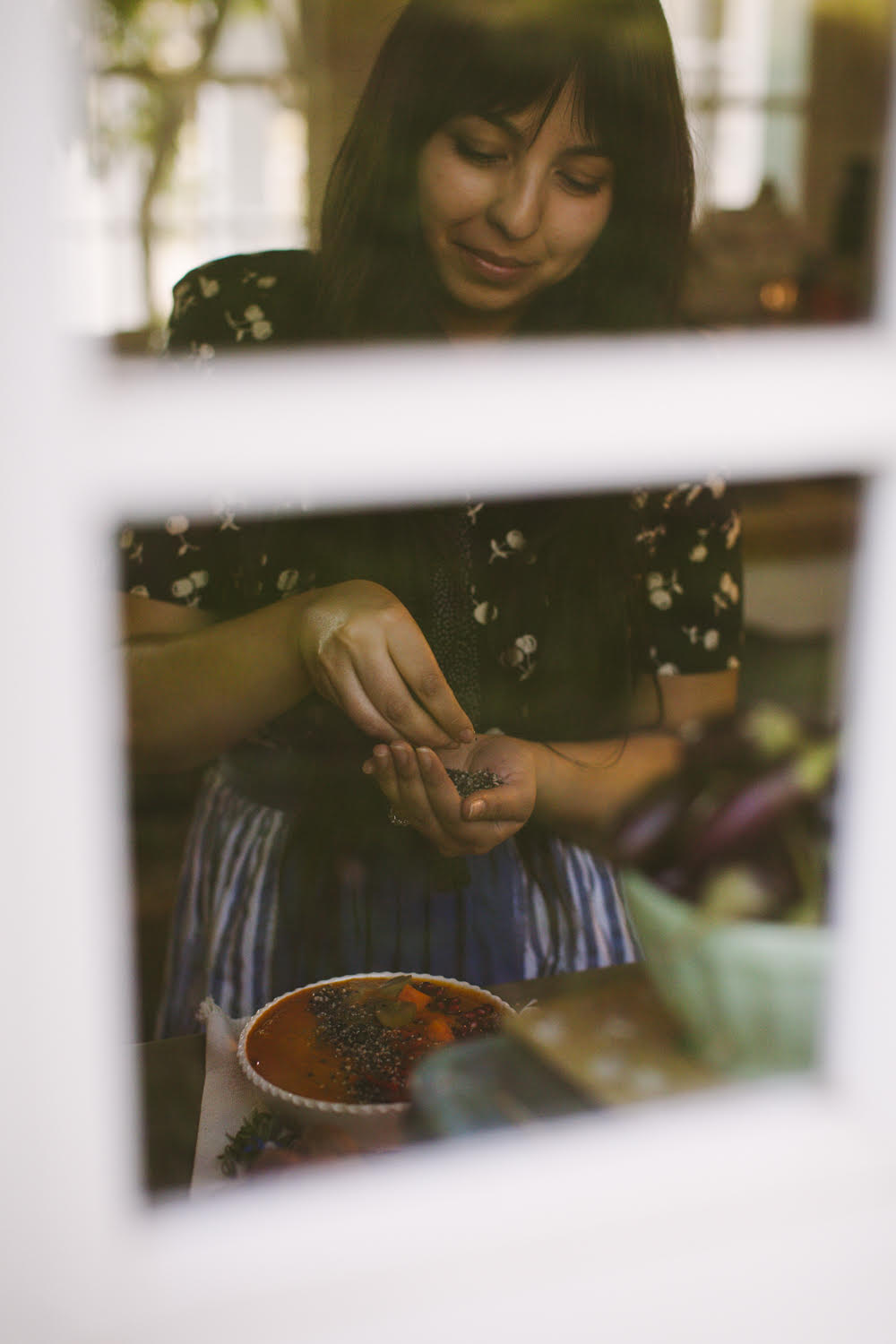
Even though my professional kitchen background is mostly in pastry and confections, I felt like the market was already flooded with enough sweets, and we wanted to offer something that was a bit healthier that was easy to integrate into your daily life. I also really wanted to develop a few products that were made with actual whole food ingredients. I worked as a produce buyer for a few years while launching Flour Child, and had built an incredible network of local farmers to source from that I wanted to continue to support in my own business. But the challenge with edibles is that they also need to be shelf-stable (well, that wasn’t a requirement at the time but I felt that it should be, as I had personally purchased several in the past that were moldy, stale, or obviously improperly stored).
So, that’s where the Jam came in. It was a way to have a seasonal product, made with peak-season fruit from the farmer’s market, yet it could be canned and sit on a shelf for months and months safely. Something I love so much about preserves is the ability to transport yourself to another season by opening a jar; there’s something magical about popping open a can of summer peaches in the middle of winter. We chose to dose the jam gently because, again, especially at the time, there were very few options for lower-dosed edibles. Each teaspoon had 2.5 mg of THC, or 7.5 mg per tablespoon. We wanted to make it really easy to measure your dose, according to your needs.
The granola came about similarly. It’s made with real, whole food ingredients, much of it sourced locally, and meant to be enjoyed on a daily basis. We use California Arbequina olive oil, dark maple syrup, and lots of dried Knoll Farm figs — a mix of the several dozen varieties they grow. We also chose the granola because it goes so well with jam, so folks who might need a higher dose could easily put together a little parfait with yogurt and fresh fruit to get their milligrams in without having to eat a brownie.
I know that you craft Flour Child’s infused jams with strain-specific cannabis to match your preserves. Can you tell me more about that matching process and what strains you use to pair with specific fruits?
Absolutely! I’ve always thought of cannabis as just another ingredient. My approach is not to mask the flavor of cannabis, but rather to treat it like an herb and work with it. Find complementary flavors that work together to balance. Just think about making a dish you really love, and how it’s finished with a specific herb or combination of herbs. Something that is amazing with a little mint or cilantro at the end wouldn’t really have the same effect with, say, rosemary or dill. Sometimes it is interchangeable, depending on the dish. Really, a lot of it was trial-and-error and just following your nose. We knew from the start we wanted to do strain-specific edibles, but it wasn’t really until we started cooking that we noticed a huge difference in how some strains paired with particular fruits.
When cooking with concentrates like rosin or ice water hash, you have a lot less of a typical “weed” flavor in your edibles, compared to using trim or flower-based infusions. The flavor and aroma profiles can vary drastically, though, from sweet and fruity, to bright and citrusy, to deep and earthy. During our first year, we were right in the beginning of summer fruit season and making tons of flavors. We had a batch of hash that was on the earthier side, I think it might’ve been like a Chocolate Hashberry or something. It worked out great in the Blackberry, Raspberry, and Tayberry Jams, but when we added it to the Apricot Rose, it was so prominent that it overwhelmed the delicate flavors in the jam itself. That was when we started to learn more about terpenes and why certain things work or don’t.

We realized that punchier fruits like dark berries could stand up to stronger flavors, but that the more delicate fruits of the bunch were better expressed by pairing with similarly delicate aromas. For example, the very citrusy strains like Lemon Haze are perfect to highlight the softer flavors of stone fruits. As we developed relationships with growers and started to make our own rosin in-house, we were able to take this to the next level because we could pick exactly what strain we wanted and press it to the exact profile we wanted.
Bon Vivant in Mendocino grows some of the most incredible flower we’ve ever seen, and working with them we made things like Strawberry Jam — made with Strawberry Banana flower rosin and my favorite varietal, mara des bois, which has such an uncannily similar aroma to the Strawberry Banana strain. Like sweet, wild strawberry-grape-y vibes. It melded together so well that it was hard to tell where the fruit ended and the rosin began; it just sort of adds another layer of complexity to the mix, rather than being a separate flavor. Blood Orange with Sour Tangie rosin was another favorite.
From what I understand, Flour Child uses flower rosin for all of your infusions. What is it about rosin pressed from flower, as opposed to other concentrates, that makes it so perfect for your uses?
Rosin just tastes so good, and is such a dream to cook with since it just melts right into whatever you’re making. We only use non-solvent based extractions in our edibles. I wouldn’t feed you butane if you came over for dinner, so why would I use it in edibles? I also believe that whole-plant medicine works better than isolating just one compound, and that the terpenes are a big part of the remedy. As such, we didn’t want to use distillate or anything like that, which has become so popular. Edibles should taste like cannabis! If you use good weed, it’ll taste good. If you use trim, well, it’ll taste like trim.
Starting out, we used ice water hash that we sourced from a number of local makers. Ice water hash is also lovely to cook with, but we started running into issues with consistency and quality. Plus, we wanted to bring the concentrate making in-house so that we could choose the flower from the very beginning and have control over the process a bit more. Rosin was just starting to take off, and, for us, it made more sense to produce rosin than ice water hash simply because it requires a lot less space and time to make properly than ice water hash. You can basically press it, gather it, and use it right away, whereas ice water hash needs a lot of space to wash, and then needs to dry for several weeks in order to eliminate moisture and cure properly. The first time I cooked with rosin was for an epic 420 brunch a few years back. We made wild blueberry pancakes with blueberry rosin syrup; bacon, egg & cheese bagels; and mixed berry coffee crumb cake. It’s so easy to dose, tastes amazing, and you don’t have to worry about straining things and making a huge mess in your kitchen.
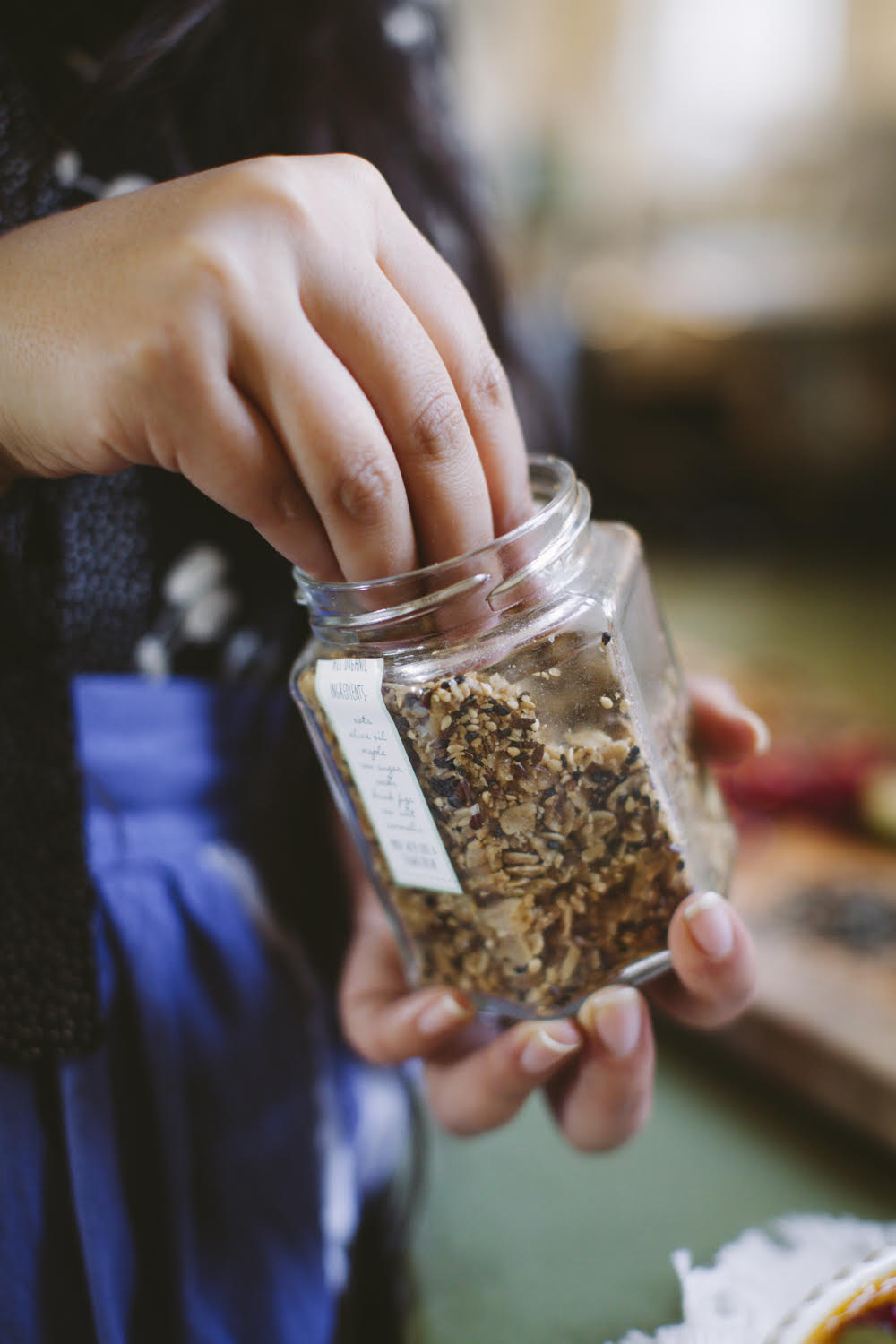
In addition to your jams, granola, rosin, and topicals, the Flour Child Instagram page is full of other gorgeous infused dishes from your kitchen. How important is it to keep experimenting with cannabis cooking, and how do you find the time?
For me, it’s very important to keep experimenting with cannabis cooking. I’ve always got a huge list of things I want to try out, and I’m always adjusting recipes to make things better. Truthfully, it’s hard to find the time — you really have to make the time. I’m really lucky to have sort of made it my job and have to do these things!
The last few months, I’ve been working on a line of rosin-infused, fruit-based confections inspired by Turkish delight I had on a trip to the Middle East last spring. I’m kind of a huge nerd about cannabis history (I know, shocking), and Turkish delights are perhaps the most OG of all edibles — hash has been a huge part of life and tradition in the Middle East and Europe, and these chewy confections were often infused with hash (usually finger hash back then, or “snow hash” — aka ice water hash if very fancy). I’ve been wanting to make an edible inspired by that for years, and it’s been so fun getting to play around with them. These are a less sweet, organic, modern take on them, inspired by the flavors of California and all of the cultures who’ve made this place home — Rose Hibiscus, Alphonso Mango, Matcha Coconut Lime, and Sour Cherry Vanilla to start. Then we’ll be releasing limited-edition seasonal flavors like Mara des Bois Strawberry and Flavor King Pluot. They’re called Rose Delights and will be launching very soon! Stay tuned.
.jpeg)
I’ve also been doing some recipe development and food styling for other edibles companies — like Pop-up Potcorn, a new Bay Area-based company making cannabis-infused microwave popcorn. I’ve got a few easy recipes for things to make using the delicious organic popcorn (you can find them on their website and Instagram!).
We’re also working on re-launching our line of products, and adding a few more items to the collection, as well as building a repertoire of recipes to show people how to make things at home and help them gain confidence in making edibles. This past year, we contributed a recipe to a wonderful cookbook written by our friends Stephanie Hua and Coreen Carroll. It’s called “Edibles: Small Bites for the Modern Cannabis Kitchen” and you can find it at your local bookstores or online. They did an amazing job of breaking down different infusions, dosages, and all the basics (and not-so-basics) of cooking with cannabis. I’ll be speaking on a panel with them in a few weeks for a Crop-to-Kitchen event on cannabis and cooking. If you’re at all interested in making edibles at home, it’s a wonderful primer and a gorgeous book in it’s own right, whether or not you choose to infuse.
For more information about Stephany and the Flour Child Collective, visit FlourChild.org and follow them on Instagram.


